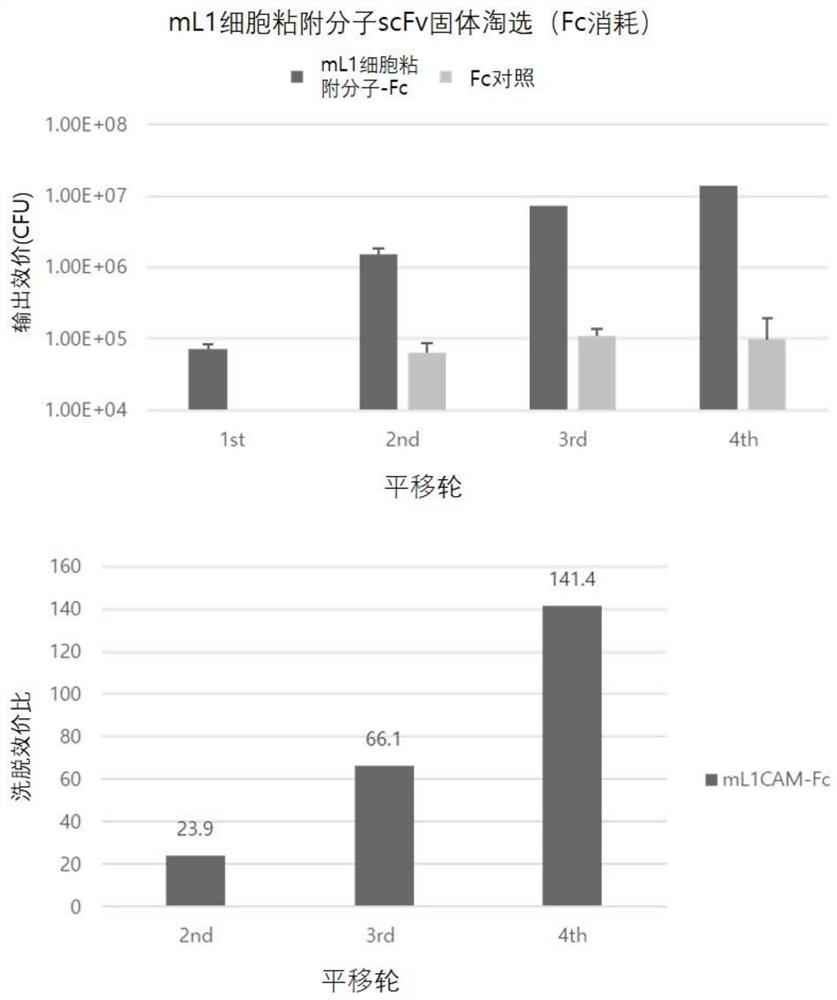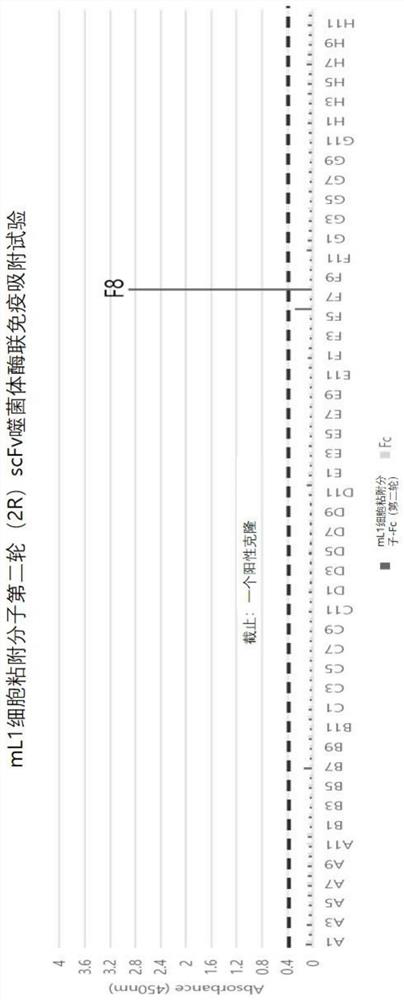Anti-L1CAM antibody or antigen-binding fragment thereof and chimeric antigen receptor comprising same
A technology of adhesion molecules and binding fragments, applied in the direction of anti-receptor/cell surface antigen/cell surface determinant immunoglobulin, receptor/cell surface antigen/cell surface determinant, animal cells, etc., can solve the therapeutic effect Insufficient and other problems, to achieve the effect of excellent specificity and affinity
- Summary
- Abstract
- Description
- Claims
- Application Information
AI Technical Summary
Problems solved by technology
Method used
Image
Examples
Embodiment 1
[0219] Example 1: Screening for scFv antibodies to L1 cell adhesion molecule antigens
[0220] 1.1. Human synthetic scFv phage display antibody library panning
[0221] In order to screen the anti-mL1 cell adhesion molecule scFv antibody that binds to the mouse L1 cell adhesion molecule (mouse L1 cell adhesion molecule, mL1 cell adhesion molecule) antigen, a human synthetic scFv phage display library (KscFv-1, KBIOHEALTH ) 4 rounds of phage panning for the antigen mL1 cell adhesion molecule protein ( figure 1 ). Antigen mL1 cell adhesion molecule protein (R&D system, Cat No. 5674-NC) was added to the immunotube (immunotube), cultured at 4°C overnight, and then, 5% skim milk (skim milk) was used to Phosphate buffered saline (MPBS) was reacted at room temperature for 1 hour, and the blocking process was carried out. A phosphate buffer solution containing skim milk was added to KscFv-1, and reacted at room temperature for 1 hour to prepare blocked phage. The blocked phages we...
Embodiment 2
[0280] Example 2. Anti-L1 Cell Adhesion Molecule-Chimeric Antigen Receptor Gene Expression T Cell Preparation and Efficacy Confirmation
[0281] 2.1. Anti-L1 cell adhesion molecule-chimeric antigen receptor gene ensures
[0282] 2.1.1. Ensuring anti-mL1 cell adhesion molecule scFv antibody gene
[0283] Anti-L1 cells were ensured from the cloned phagemids containing the anti-L1 cell adhesion molecule scFv screened in the present invention by sequence analysis using the Lac promoter-forward primer (Lac promoter-forward primer). Base sequences of adhesion molecule scFv clones (Table 5). Based on the base sequence analyzed, a forward primer and a reverse primer were prepared, and the above-mentioned phagemid was used as a template to amplify by the polymerase chain reaction method to ensure the polymerase chain reaction. reaction product. Using the polymerase chain reaction product of the secured anti-L1 cell adhesion molecule scFv antibody as a template, the primers of sequen...
Embodiment 3
[0322] Example 3. Confirmation of efficacy (in vivo) of anti-L1 cell adhesion molecule-chimeric antigen receptor gene expressing T cells in vivo
[0323] In order to confirm the anticancer activity of anti-L1 cell adhesion molecule-chimeric antigen receptor gene-expressing T cells in vivo, a cancer-induced animal model was used. In the subcutaneous (subcutaneous, SC) subcutaneous (subcutaneous, SC) administration of 3 × 10 NOD / SCID mice (7 weeks old, female) lacking T cells, B cells, natural killer cells (NK cells) 6 Individual SKOV3 cancer cells (Target, T) mixed with Matrigel (Matrigel) at a ratio of 1:1 were used to induce cancer. Three days after cancer cell administration, two L1-chimeric antigens whose efficacy was confirmed in vitro as anti-L1 cell adhesion molecule-chimeric antigen receptor expressing T cells were administered once a day to each NOD / SCID mouse Receptor-002 and L1-Chimeric Antigen Receptor-004 and the T cells of the control group were administered 3 ti...
PUM
 Login to View More
Login to View More Abstract
Description
Claims
Application Information
 Login to View More
Login to View More - R&D
- Intellectual Property
- Life Sciences
- Materials
- Tech Scout
- Unparalleled Data Quality
- Higher Quality Content
- 60% Fewer Hallucinations
Browse by: Latest US Patents, China's latest patents, Technical Efficacy Thesaurus, Application Domain, Technology Topic, Popular Technical Reports.
© 2025 PatSnap. All rights reserved.Legal|Privacy policy|Modern Slavery Act Transparency Statement|Sitemap|About US| Contact US: help@patsnap.com



